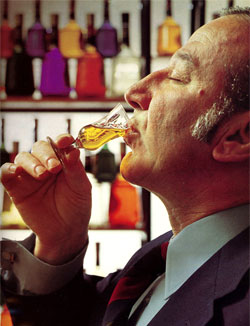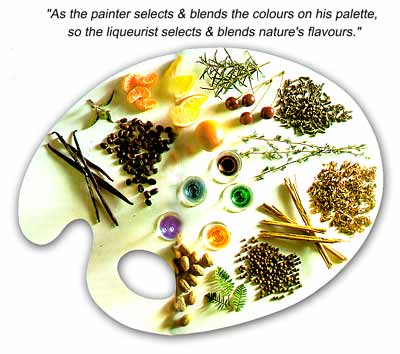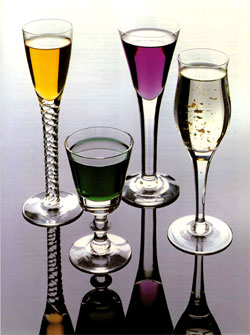Appreciating Liqueurs

"Appreciate" has various shades of meaning; it can mean to increase in value, to esteem highly, to form an estimate of quality and, what we are really getting at, to be sensitive to and sensible of any delicate impression or distinction. An appreciation of liqueurs (or anything else worthwhile for that matter) entails the use of all our critical faculties and senses. It implies that we will take some time to look, to smell and to taste. And that, to the best of our ability, we will make comparisons and judgements between and against standards known and remembered. This does not mean we may allow ourselves to be prejudiced or have pre-conceived ideas. Each time we come to an "appreciation" it should be with an open mind seeking to find aspects not explored before.
Properly done the appreciation of liqueurs is an art, almost a science, certainly a trade for some men. But it is an art, the rudiments of which are simply learnt and with application it becomes easier and more enjoyable on each new occasion. There are some simple ground rules which help to make progress easy and these I will set out for you. If you have found the earlier chapters interesting you will know already some of the things you should be looking for as you proceed.
Glassware. It may sound a truism, but glasses are essential for a proper appreciation. One must be able to see the colour and so a metal goblet, be it of the finest gold, is useless since this only allows us to see reflected light and not refracted light, so important to an understanding of the colour. So we must use glass, clear uncoloured glass in order that only the liqueur's own colours will be seen. Naturally it must be finely polished and unblemished with finger marks so a stemmed glass is preferred. The small 30ml waisted liqueur glass is adequate although for a true appreciation a larger glass only part filled is preferable. Liqueur judges use thistle-shaped or dock laboratory glasses with a generous bowl and a narrow opening so that the bouquet is more easily detected. They resemble tall brandy balloons.
Temperature. Liqueurs are best appreciated at room temperature but for normal entertaining many people prefer to serve some liqueurs (Mite Curacao, Cherry Brandy, etc.) chilled.
Colour. There are a few liqueurs which are totally without colour (Mite Curacao is one), but even these should be inspected by holding to the light to see if there is any slight tinge or cloudiness. For the many others which are coloured you should pause and observe all the various tints and hues which will be there. There is no pure red in liqueurs; if you look closely you will see a ruby colour with tinges of blue, violet, magenta, amber and others. The greens will all be different, some with yellow in them, some almost black. Parfait Amour is particularly good to look at in this way. It changes colour in dramatic fashion as the glass is turned and the light strikes from different directions.
Bouquet. You should now proceed to smell or 11 nose" the liqueur as we say in the trade. Inhale the bouquet quite deeply two or three times without tasting. If you are careful and thoughtful and perceptive and if you have a good liqueur in your glass you will find each time a little something extra that was not there at first. If your sample in this case is Goldwasser, your first impression may be "orange peel" but next and deeper you may find some Aniseed coming through followed by nutmeg, some flower perfume? But I cannot help you too much -try for yourself.

Palate. At this point you may start sipping. But only sipping! With each sip roll the liqueur over the tongue and right around the mouth, from the front to the very back. Take a little air in through the lips and suck this through the liqueur so that the flavour is carried well up onto the back palate. It may sound a little over-theatrical but try again with your eyes closed and concentrate hard. You will find many different and isolatable aspects. Firstly there will be the texture and this may be thin or smooth or thick. It should of course be agreeable. Then there will be the sensation of the spirit which will be warming, perhaps hot on the tongue and palate. And finally there will be the basic flavours of which there may be only one for your palate to discern but hopefully many more as you become adept. (Our Goldwasser has thirty-four to tantalize you!) It is fascinating; sometimes a flavour will be dominant at first taste and then seem to disappear only to return at a later stage.
Finish. No matter how perceptive you have been and how many components you may have isolated on the nose, and later on the palate, they must all come into harmony at the finish. Liqueurs may be dry and acid, they may be sweet and soft, but at the end they should lie softly and gently on your palate with no rough edges, no harsh notes, no awkward lingering of any one aspect. In short, if the liqueurist has done his job well, all will be in balance.
Judging. The judging of liqueurs to a professional standard is Appreciation carried to its highest point. It is possible you will never be called upon to express a judge's opinion; indeed it is quite likely that you may not even be in the position to "look at" more than one or two samples at the one time. Nevertheless it is interesting to know how one should go about the task. Let us suppose we are going to judge a range of samples of Cherry Brandy. Someone else, that is to say not the judge himself, will set out sufficient identical glasses in a line across the judging table into which a sample of each liqueur is poured. The glasses are usually identified with a number from left to right. The bottles are then removed somewhere out of sight so they will not influence or predispose the judge. A judging sheet should be provided for the use of the judge set out so as to make his task easy and the headings of the columns are as follows -
Sample No. | Colour (3 points) | Aroma (5 points) | Palate (12 points)
Every judge has his own particular and peculiar fashion of judging but most will commence by examining the samples for colour and condition by first lifting each glass one after the other, swirling the liquid about and replacing them on the table in a certain order, either nearer to him if he likes them or away from him if they please him less. Having done this he will award them points up to a maximum of 3. For example 1.5,2.6,2.8,1.2 and so on. He will rely on his experience as well as his powers of observation to say which of the samples most truly show the colour and condition required in the particular liqueur. After this he will proceed to examine the range for Aroma, nosing each in turn, placing them back and forth on the table and finally pointing them to a maximum of 5 points.
And finally he will taste them, looking all the while for the good and bad points of each, watching for unusual flavours, making sure the spirit is clean and that the total effect on the palate is harmonious and in keeping with the style expected of the class of liqueur being judged. Since the flavour of a liqueur is of paramount importance he will give a maximum of 12 points. When all of this has been done he will total his points so that, hopefully, one liqueur will emerge as a clear winner.
 In most shows conducted by Agricultural Societies in Australia, Awards are made: Gold, Silver or Bronze. The grading of these depends on the judges' points, so that if a liqueur has been given 15.5 points and up to 16.9 points, it will be accorded a Bronze Award. If it gained 17 to 18.4 points it will get a Silver Award and if 18.5 to the maximum of 20, it will receive a Gold Award, the highest possible. If, as is usual, there is a panel of judges, they will combine their points for each sample and by averaging arrive at a consensus of opinion.
In most shows conducted by Agricultural Societies in Australia, Awards are made: Gold, Silver or Bronze. The grading of these depends on the judges' points, so that if a liqueur has been given 15.5 points and up to 16.9 points, it will be accorded a Bronze Award. If it gained 17 to 18.4 points it will get a Silver Award and if 18.5 to the maximum of 20, it will receive a Gold Award, the highest possible. If, as is usual, there is a panel of judges, they will combine their points for each sample and by averaging arrive at a consensus of opinion.
Without going into the philosophy of judging and the arguments in favour of and against the panel system, I think it can be fairly said that most usually a fair result is obtained. Certainly a panel tends to reduce the likelihood of one single judge who has a wrong or unnatural bias towards a particular style, awarding one sample very high points which it may not truly deserve, or more importantly failing to give points to a deserving sample merely because he has a blind spot or antipathy towards certain aspects of it. Judging is hard work done properly but it is fascinating too. Why not try it for yourself. It may be you will think it a bit expensive to purchase five bottles of Cherry Brandy merely to decide which you like best. (You are bound to end up with one or two which you have judged and found wanting!) But most liqueur makers pack small bottles of about 200 ml. and these make a most economical way to try a range.
Go to it! Become your own expert!
General Tips for Cooking with Liqueurs
The astute host will discover that good food is enhanced by the addition of liqueurs. Liqueurs find their way into recipe books for all courses and types of food. Common sense, as well as a good recipe, can produce wonders. Terrines and pates often include a liqueur in their ingredients - not only for its obvious improvement in flavour but also for its keeping qualities of the dish.
An adventurous host can find that the simple addition of a liqueur to a fruit salad or bowl of whipped cream immediately elevates it into the class of haut cuisine e.g. Kirsch added to cream or fruit. The most mundane dessert can be improved by the addition of a small amount of liqueur. Strawberries, a beautiful fruit in themselves, are absolutely delicious served as the classical dessert "Strawberries Romanoff". Another variation on the fruit plus liqueur theme is the simple but effective art of flaming fruit at the table, which restaurants perform with such aplomb.
The Art of Flaming
Warm liqueur in a small saucepan; ignite and pour over fruits at the table. Serve immediately to the acclaim of guests. Souffles, whether of the cooked or refrigerated variety lend themselves to the addition of liqueur e.g. chocolate peppermint or coffee liqueur in a chocolate souffle. Liqueurs make an ideal topping for ice creams as the richness of the liqueur flavours blend harmoniously with the creaminess of the ice. Fruit liqueurs make natural dessert partners with ice cream. Liqueurs which are herb based are ideally used in casserole cooking, in pastries, and lend themselves particularly well to poultry. The combinations are limitless, so with careful experimentation discover the international fascination of cooking with liqueurs. In the following pages you will find a selection of recipes. Enjoy!
